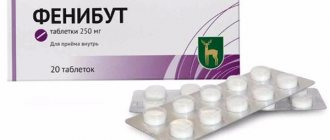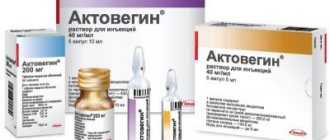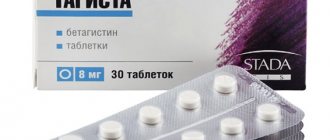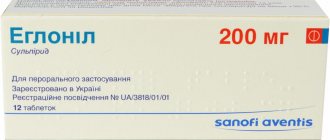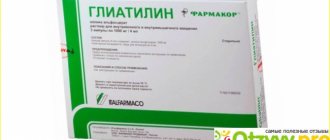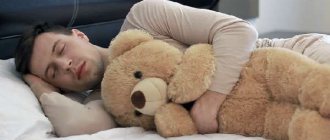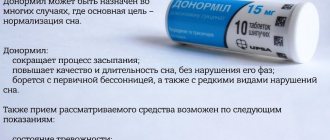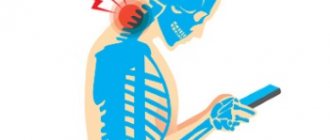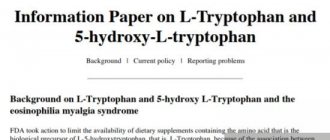Characteristics of Finlepsin retard
Finlepsin is an anticonvulsant. Acts on skeletal muscles. It is used to relieve seizures and reduce the likelihood of their occurrence. In addition, the remedy is used for mental disorders if anxiety occurs.
Finlepsin is an anticonvulsant. Acts on skeletal muscles.
Release form: tablets. They are round, convex on both sides. They have a whitish tint. The main active ingredient is carbamazepine. One tablet contains 200 mg of this compound. In addition, the composition also includes auxiliary compounds. Tablets are sold in blisters of 10 pcs. There are up to 5 such plates in a pack.
https://www.youtube.com/watch?v=wJHZ3-k5gek
Carbamazepine is a derivative of dibenzazepine. The substance blocks the effect on sodium channels of the cellular structures of the nervous system, including the brain. Their increased activity is eliminated, impulses are suppressed.
The drug has a therapeutic effect:
- Anticonvulsant. Acts on motor neurons of the human brain. Thanks to this, the medicine helps with seizures due to epilepsy.
- Antipsychotic. Anxiety and nervousness decrease, the depressive mood will not be as pronounced, and aggressiveness of various etiologies disappears. The latter even applies to alcohol addiction and alcohol withdrawal.
- Painkiller. Helps with neuritis, when neurocytes become inflamed. The etiology can be any.
After taking the tablets orally, the active compound gradually and completely enters the general bloodstream. It is evenly distributed throughout the tissues and penetrates into the central parts of the nervous system. The drug breaks down in the liver, forming active and inactive compounds that are excreted from the body in urine and feces. The half-life is up to 1.5 days.
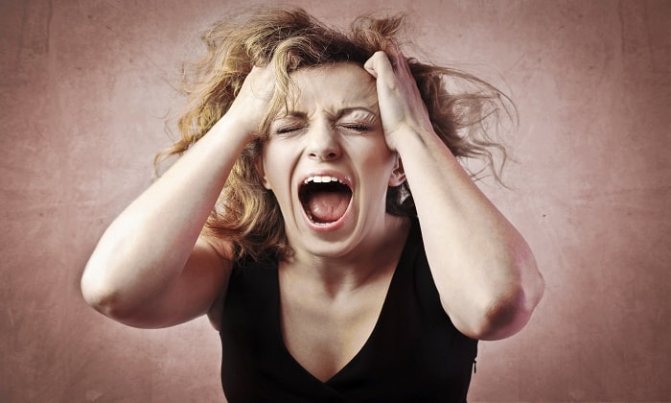
Finlepsin helps cope with anxiety and nervousness.

The drug Finlepsin reduces depressive mood.

The drug should be taken during or after meals, washing down the tablets with plenty of water.
Finlepsin tablets should be taken during or after eating. They cannot be chewed or crushed into powder. It is recommended to drink plenty of water.
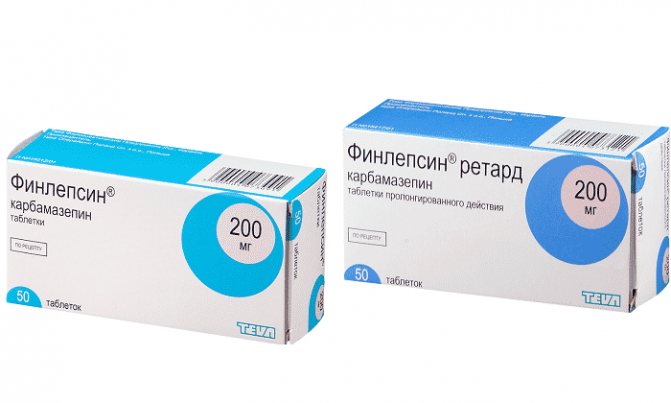
The treatment regimen and dosage depend on the disease:
- Epilepsy. In this case, the medication is suitable for monotherapy. At the beginning of treatment, dosages are minimal. For adult patients - 1-2 tablets, i.e. 200-400 mg. As a maintenance amount, the drug is taken from 800 to 1200 mg per day. This daily dose is divided into 2-3 doses. The maximum amount should not be more than 2 g. For children under 5 years of age, the dosage is 100-200 mg, but it can be increased to 400 mg. For a child under 12 years of age - from 200 to 600 mg.
- Neuralgia of the glossopharyngeal nerve. You should start with 200-400 mg and increase to 800 mg.
- Alcohol withdrawal. Treatment is carried out in a hospital setting. The initial dose is 600 mg per day. This amount should be divided into 3 servings, but then the daily dose should be increased to 1200 mg. The use of the drug should be stopped gradually.
- Pain due to neuropathy caused by diabetes. 600 mg per day is allowed. In the most severe cases - up to 1200 mg.
- Epileptic type seizures associated with multiple sclerosis. It is recommended to take 400-800 mg once a day.
- Psychoses. To treat and prevent them, you first need to take 200 mg per day, and then increase the volume to 800 mg.
The duration of therapy is determined by the doctor individually for each patient.
The drug is an anticonvulsant. It can be purchased in tablet form for oral use. They are whitish, round, sold in blisters of 10 pieces. Each contains 200 and 400 mg of carbamazepine, the main active ingredient. In addition, there are also auxiliary connections.
The dosage and duration of therapy is determined by the doctor individually for each patient, depending on the characteristics of his body and the severity of the disease. Initially, the dosage ranges from 100 to 400 mg per day. If necessary (there is no therapeutic effect), you can increase the dosage every week by 200 mg.
For children under 6 years of age, the dosage is calculated depending on weight - 10 mg for every 1 kg of body weight. The resulting amount should be divided into 3 doses. Children from 6 to 14 years old are prescribed 200 mg per day, but this portion must be taken 2 times. If the effect is insufficient, then it is allowed to increase by 100 mg. The maximum amount per day for children is 1000 mg, for adults - 1200 mg.
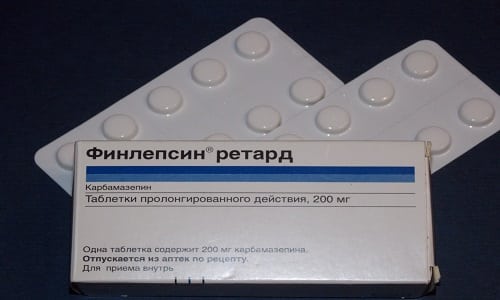
The drug is an anticonvulsant. It can be purchased in tablet form for oral use.
Overdose
Symptoms: usually reflect disorders of the central nervous system, cardiovascular and respiratory systems.
From the central nervous system and sensory organs: depression of central nervous system functions, disorientation, drowsiness, agitation, hallucinations, coma, blurred vision, slurred speech, dysarthria, nystagmus, ataxia, dyskinesia, hyperreflexia (at the beginning), hyporeflexia (later), convulsions, psychomotor disorders , myoclonus, hypothermia, mydriasis.
From the cardiovascular system: tachycardia, decreased blood pressure, sometimes increased blood pressure, intraventricular conduction disturbances with widening of the QRS complex, fainting, cardiac arrest.
From the respiratory system: respiratory depression, pulmonary edema.
From the digestive system: nausea and vomiting, delayed evacuation of food from the stomach, decreased motility of the colon.
From the urinary system: urinary retention, oliguria or anuria, fluid retention, hyponatremia.
Laboratory indicators: leukocytosis or leukopenia, hyponatremia, possible metabolic acidosis, possible hyperglycemia and glycosuria, increased muscle fraction of CPK.
Treatment: there is no specific antidote. Symptomatic supportive treatment in the ICU, monitoring of heart function, body temperature, corneal reflexes, kidney and bladder functions, and correction of electrolyte disorders are necessary. It is necessary to determine the concentration of carbamazepine in plasma to confirm poisoning with this drug and assess the degree of overdose, gastric lavage, and the administration of activated charcoal.
Late evacuation of gastric contents can lead to delayed absorption on days 2 and 3 and the reappearance of symptoms of intoxication during the recovery period. Forced diuresis, hemodialysis and peritoneal dialysis are ineffective, but dialysis is indicated for a combination of severe poisoning and renal failure. Young children may require blood transfusions.
Comparison of Finlepsin and Finlepsin retard
To determine which drug is better, it is necessary to study them, highlight their similarities and distinctive features.
Similarities
Indications for the use of Finlepsin and Finlepsin retard are various problems in the functioning of the central nervous system, which lead to movement disorders, mental disorders, and pain. Both drugs are prescribed in the following cases:
- epilepsy and increased frequency of seizures;
- seizures of the epileptic type, caused by muscle spasms, multiple sclerosis, and also leading to disturbances in the sensitivity of the skin, problems with gait and speech;
- pain due to neuritis and neuralgia of the facial nerves;
- pain associated with disorders of carbohydrate metabolic processes in diabetes mellitus;
- psychotic disorders.

Contraindications to the use of Finlepsin and Finlepsin retard are as follows:
- disorders of hematopoietic functions;
- atrioventricular block;
- porphyria in acute form;
- individual poor tolerability of the drug or its components, as well as medications from the group of tricyclic antidepressants.
You cannot take lithium preparations and Finlepsin or Finlepsin retard at the same time. The same applies to the use of monoamine oxidase enzyme inhibitors with them. The drug is prescribed with caution during pregnancy and lactation, dysfunction of the heart, liver, kidneys, and prostate.
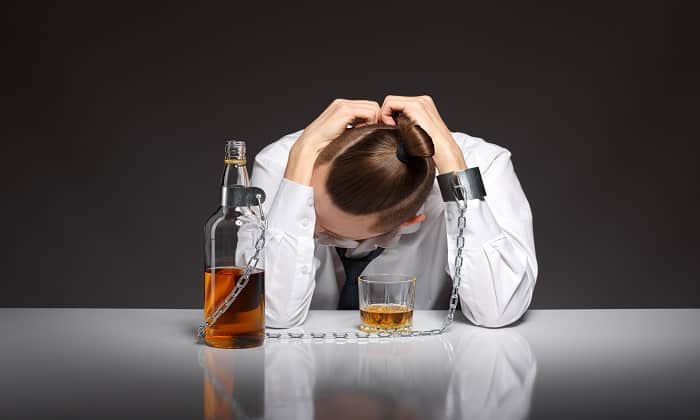
Both drugs are used to treat chronic alcoholism.

Medications are prescribed with caution during pregnancy.

While taking the drug, the patient may experience attacks of nausea and vomiting.
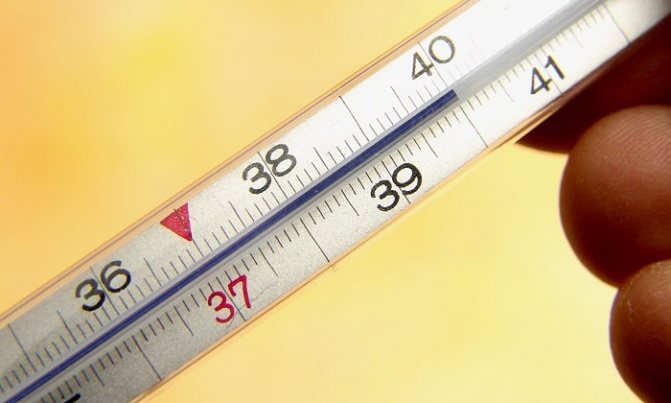
It is possible that medications will cause an increase in body temperature.

Side effects of drugs may manifest themselves through drowsiness.
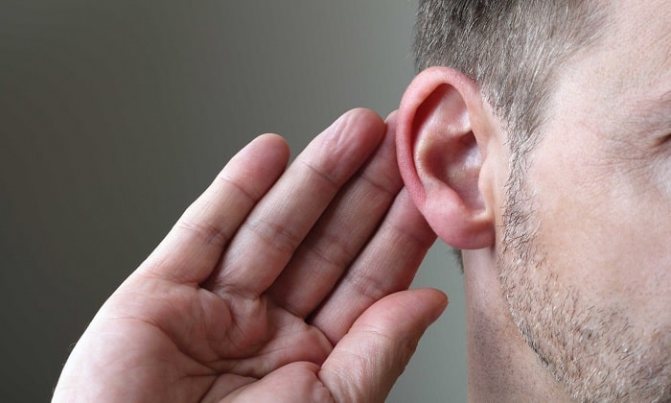
Therapy with the drugs mentioned may lead to hearing impairment.

In some cases, medications cause loss of appetite.
https://www.youtube.com/watch?v=jkFU3jOhDRE
The side effects of both drugs are the same. These include:
- nausea, vomiting, feeling of dry mouth, increased activity of liver enzymes, abdominal pain, alternating diarrhea and constipation, stomatitis, hepatitis, pancreatitis;
- increased body temperature;
- interstitial nephritis and various problems with the genitourinary system;
- hearing impairment;
- dizziness, muscle weakness, drowsiness, loss of appetite.
In all these cases, it is necessary to stop using the drugs.
What is the difference
Finlepsin retard differs slightly from the original drug. It has a prolonged effect due to other proportions of the main component in the tablets. When the medicine enters the stomach, it is released gradually. Thanks to this, the concentration of the substance in the blood is maintained at a sufficient level for a long time, reducing the risk of adverse reactions.
Which is cheaper?
Finlepsin can be purchased in Russia for 225-245 rubles. The price for Finlepsin retard is about 220 rubles.
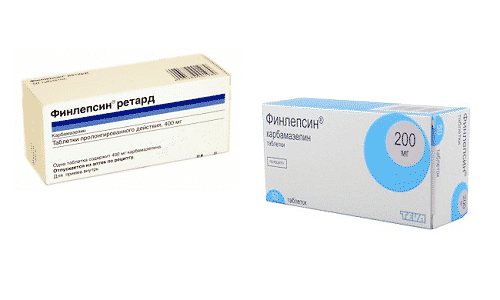
The drugs are interchangeable medications, that is, they are considered analogues.
TEGRETOL
Name:
Ilya Vumani Yusupov
Review:
tell me why tegritol works bad 1 head spinning 2 weak 3 kaksnu pulls why you know
Name:
Pavel Kataev
Review:
I have extreme sleepiness. I had to quit
Name:
wader waderr
Review:
After half a year, the drowsiness goes away. But even though it has an antidepressant effect, it doesn’t help. How many times have I wanted to drink the whole box, but I restrained myself at the last moment. Or she was simply taken away at the last moment.
Name:
Mikhail Stolbov
Review:
For bipolar disorder, it is good to use it together with an antidepressant. It is relatively easily tolerated compared to other normatives, such as Lithium and carbamazepine.
Proper care of affected skin with shingles
In order for the treatment to be more successful, in addition to taking medications, you need to be able to properly care for the affected skin. This will help relieve severe itching and significantly reduce soreness.
Basic recommendations:
- Wash skin with rashes twice a day under running water and soap;
- During treatment, wear only loose-fitting clothes so as not to injure the skin;
- apply cold compresses to help relieve itching;
- Using a sterile elastic bandage, you can cover the affected area (if it occupies a small area).
Personal hygiene and simple care of lesions will bring a speedy recovery.
You can get rid of the disease only with the help of complex therapy. Before starting treatment, be sure to consult a doctor and confirm the expected diagnosis.
Carbamazepine or Finlepsin – which is better?
Carbamazepine is a domestic analogue of Finlepsin with the same active ingredient.
It has the same therapeutic effect, the indications, contraindications and side effects are similar. The cost of the medicine is up to 5 times lower. The difference between the analogue is that it is produced in one dosage of 200 mg and does not have a prolonged form. Finlepsin has several convenient forms for use and has been clinically studied. When using it, unwanted reactions are less likely to occur.
Tegretol is a Swiss drug based on carbamazepine. Both analogues have the same indications, contraindications, and adverse reactions. They differ in cost - the Tegretol analogue is more expensive.
Reviews of both medications from doctors and patients are positive. Dispensed with a doctor's prescription.
Why does shingles cause pain?
The main causes of pain with herpes zoster are a rash and a large area of skin damage. As the disease develops, the proper functioning of nerve cells is disrupted, and as the virus actively multiplies, the nerve endings become too sensitive.
How pain manifests itself
Most patients compare the pain symptom to the passage of current through the body. Burning and boring sensations bring a lot of suffering to the patient. For some, the pain manifests itself in the form of shooting, twitching or stabbing sensations. The symptom may be accompanied by itching or numbness.
In the active phase of the rash, the pain worsens at night. The greatest discomfort is felt in an uncomfortable climate (cold or hot).
Localization of pain
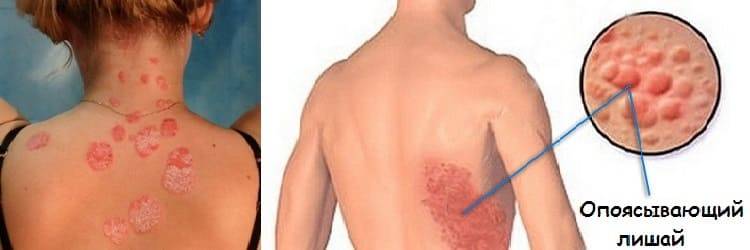
The pain will be concentrated where the rash is. This could be the back, stomach, face, chest. This suggests that these areas of the skin contain damaged nerve endings. Most often, patients complain of pain in the lumbar region or the entire back.
There are cases in which the rash is completely absent, but pain is still present.
Types of postherpetic syndrome
The disease is conventionally divided into three main phases: acute, followed by subacute, neuralgic. Each stage has its own symptoms and duration.
Let's take a closer look:
- During the acute phase, discomfort occurs, followed by pain and blistering rashes. The pain syndrome with any irritation becomes more and more intense. The stage lasts up to 30 days.
- Soreness during the second phase can last up to 100 days even after the rash has completely disappeared. Patients complain of a dull aching pain.
- In the case when the discomfort does not go away 3 months after the disappearance of the rash characteristic of herpes zoster, then they speak of the third phase - postherpetic neuralgia.
Regardless of how the pain manifests itself and what its character is, there are three types of syndrome.
Among them:
- permanent - this type is accompanied by a strong burning sensation and pressing pain;
- periodic – the patient feels tingling and sharp shooting sensations;
- allodynic – after exposure to external factors on the affected area, burning pain appears.
There are cases when a patient exhibits different types of disease at the same time.
Answers on questions
- How is Finlepsin sold by prescription or not?
To purchase the medicine, you need a prescription on a special form. - What is better – Finlepsin or Finlepsin retard?
The choice between drugs is made by a specialist based on the indications and condition of the patient. Finlepsin retard is a prolonged form containing 200 or 400 mg of active substance. Once ingested, it is gradually released, resulting in a long-lasting effect with minimal side effects. - Finlepsin - an antibiotic or not?
The drug does not belong to this group; it is an anticonvulsant (anti-epileptic) drug.
Shingles is accompanied by severe pain, which brings a lot of discomfort and suffering. To eliminate attacks of the syndrome, complex treatment will be required.
How to relieve pain
Relieving pain will require a long time and patience from the patient. Specialists include various medications in therapy.
Nonsteroidal anti-inflammatory drugs
Drugs belonging to this group of drugs are aimed at reducing pain, swelling, inflammation and reducing the flow of lymph and blood to the affected areas of the skin.
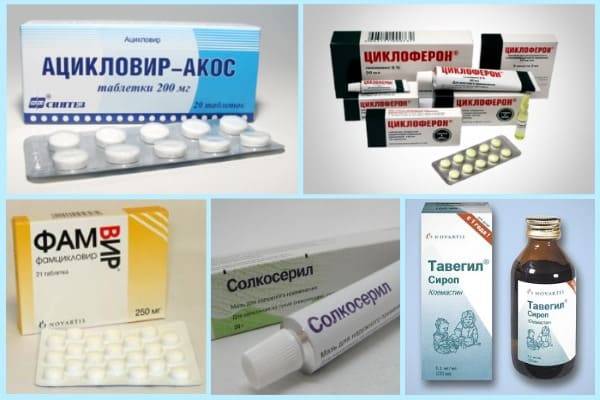
The doctor may prescribe:
- Ketoralk. Has an analgesic and anti-inflammatory effect. The medicine is taken 1 tablet every 6 hours. Treatment should not last more than a week. Reduced dosages are prescribed to patients whose weight is less than 50 kg or if their age exceeds 65 years.
- Naproxen. It has actions such as analgesic, anti-inflammatory and antipyretic. Take 1 tablet twice a day.
- Ibuprofen. Relieves inflammation and reduces pain. You need to take 1 tablet (dosage 200 mg) three times a day. The first tablet should be taken in the morning on an empty stomach, the next two doses (at lunchtime and in the evening) after meals.
Nonsteroidal anti-inflammatory drugs should be taken during the period of disease activity.
Narcotic analgesics
Drugs from this group are used as a last resort and only in cases where other drugs do not bring visible results.
Narcotic anesthetics include:
- Oxycodone. Prescribed for the treatment of neuralgia in seriously ill patients. Relieves painful attacks, blocks irritated nerve endings. The dosage and course of therapy will be prescribed by the attending physician.
- Tramadol. The drug relieves pain. In mild cases of the disease, the duration of therapy lasts several days; in severe situations, Tramadol is used for a longer period. The doctor will indicate everything.
It is important to use such medications in the exact dosage indicated. Otherwise, the patient may become addicted to the medicine.
Physiotherapeutic methods
In the acute period of development of the disease, physiotherapy methods are prescribed. The procedures are aimed at reducing pain, inflammation and improving blood circulation, which helps accelerate the regeneration of damaged tissues.
Physiotherapy procedures include:
- decimeter waves;
- transcranial electrical stimulation;
- IR laser therapy;
- ultraviolet irradiation;
- magnetotherapy.
To fight the virus, regardless of the stage, in combination with the prescribed physiotherapeutic procedure, you will need to purchase drugs to strengthen the immune system, antiviral and painkillers with a doctor's prescription.
Local painkillers and ointments
There are several ways to reduce pain, and among them are topical remedies.
Local anesthetic drugs:
- Ointments with lidocaine, for example, Herpeferon. Apply to rashes 4-5 times a day.
- Analgesic ointments, such as Acyclovir, Vivorax or Zovirax.
- Lidocaine tape. Can only be used when the rash disappears.
The medicine should be applied to cleansed and dried skin. To do this, the affected area should be washed with soapy water and blotted with a clean towel.
Immunomodulators
In order for the virus to begin its development in the human body, the protective forces, that is, immunity, must decrease. Strengthening the immune system will help overcome pathogenic activity and thereby improve overall well-being.
Immunomodulators for herpes zoster:
- Arbidol;
- Neovir;
- Cycloferon;
- Viferon (rectal suppositories).
Along with the prescribed drug, it is recommended to take a course of vitamin complexes.
How to relieve pain with folk remedies
If there are blistering rashes or sores on the skin, home remedies should be used that will not damage the integrity of the rash or cause infection.
Effective ways:
- Tree aloe. Cut off the most mature fleshy leaf, wash and remove thorns. Cut it lengthwise and apply to the affected skin. If the area with rashes is large, then you can lubricate it with aloe juice. Rinse with water after absorption.
- Ice. Ice compresses will help relieve severe burning or cutting pain. Place ice cubes in a bag and wrap in a dry towel. Apply for 5-6 minutes.
- Therapeutic baths. Stir 3-4 tbsp in a glass of water. starch. Wash the rash with the resulting solution several times a day.
It must be taken into account that traditional methods can only serve as an addition to the main treatment.
comparison table
| Drug name | Bioavailability, % | Bioavailability, mg/l | Time to reach maximum concentration, h | Half-life, h |
| Finlepsin | 70 – 80 | 76 – 80 | 11 – 12 | 25 – 65 |
| Carbamazepine | 74 – 79 | 75 – 84 | 11 – 14 | 25 – 65 |
| Tegretol | 75 – 82 | 77 – 89 | 11 – 15 | 25 – 65 |
| Finlepsin retard | 80 – 90 | 79 – 89 | 11 – 12 | 30 – 65 |
| Carbalepsin | 82 – 89 | 79– 84 | 11 – 12 | 48 – 65 |
| Actinerval | 70 – 85 | 76 – 90 | 10 – 12 | 25 – 60 |
| Zagretol | 74 – 85 | 76 – 95 | 12 – 14 | 30 – 62 |
| Zeptol | 80 – 96 | 92 – 99 | 11 – 15 | 48 – 68 |
| Mazepin | 72 – 89 | 76 – 83 | 11 – 15 | 25 – 65 |
| Stazepin | 74 – 79 | 75 – 84 | 11 – 14 | 25 – 65 |
